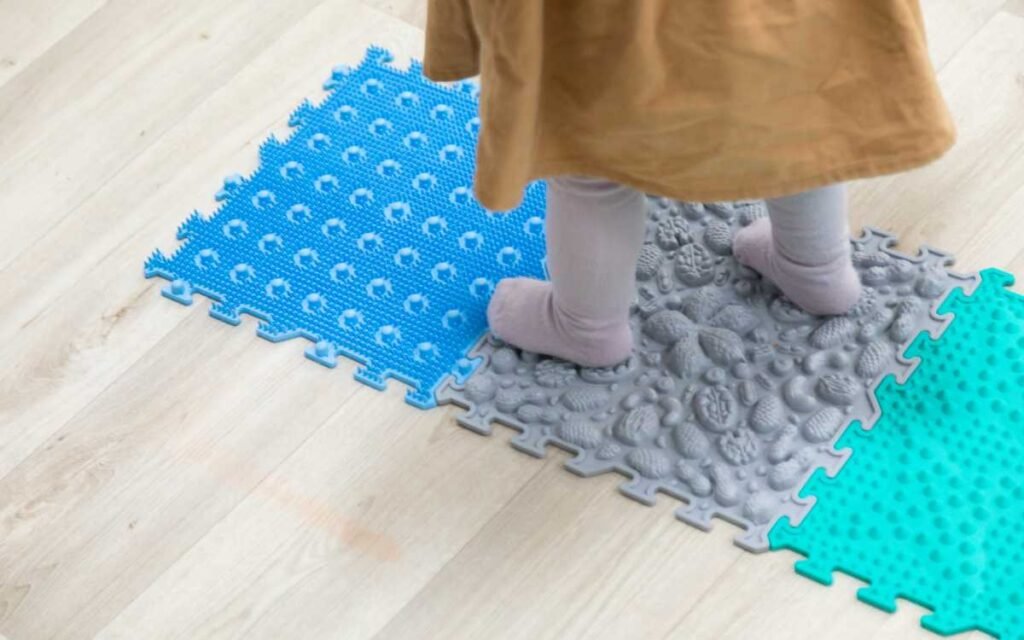
Introduction
Keeping your child safe while they play is a top priority for any parent or caregiver. Play mats provide a comfortable and cushioned surface for little ones to explore, learn, and develop new skills. But, many parents are seeking safer alternatives. They have concerns about toxic chemicals in traditional play mats.
Organic non-toxic play mats are made from natural and sustainable materials. They are free from harmful chemicals like BPA, PVC, and phthalates. These substances have been linked to various health issues, so opting for non-toxic options can give you peace of mind.
In this blog, we’ll explore the best organic non toxic play mats of 2024 to help you make an informed choice for your little one.
Top features to look for in organic non toxic play mats

When choosing an organic non-toxic play mat, consider the following features:
1. Material
- Organic Cotton: Soft, breathable, and hypoallergenic. Perfect for tummy time and crawling.
- Cork: Naturally water-resistant, durable, and easy to clean. Great for messy play areas.
- Natural Rubber: Provides excellent cushioning and shock absorption. Ideal for active toddlers.
2. Size and Thickness
Choose a mat size and thickness based on your child’s age and play needs. Larger mats provide more space for exploration, while thicker mats offer better cushioning.
3. Features
Additional features to look for include waterproofing, portability, and ease of cleaning. A waterproof mat can handle spills and accidents, while portability ensures you can take it on the go.
4. Certifications
Certifications like GOTS (Global Organic Textile Standard) and Oeko-Tex ensure the mat meets strict organic and non-toxic rules. These certifications are a good indicator of a product’s safety and quality.
Top 9 organic non toxic play mats of 2024

1. Toki Mats

Price Range: $145—$295
Toki Mats are made from natural Dunlop latex foam. The foam is OEKO-TEX-certified. Or, it is GOLS-certified organic latex. They make a safe, cushioned play surface. The mats are free of flame retardants, have anti-bacterial properties, and are biodegradable. They have removable covers in organic cotton, water-resistant bamboo, or vegan leather. They fold easily for travel and come in a variety of cover options.
Features:
- OEKO-TEX-certified natural Dunlop latex foam or GOLS-certified organic latex filling.
- Flame retardant-free, anti-bacterial, self-ventilating, and biodegradable filling.
- The covers are removable. They come in 100% organic cotton, OEKO-TEX-certified water-resistant bamboo, or vegan leather (water-based microfiber polyurethane).
- Foldable for traveling.
Pros:
- Non-toxic and environmentally friendly materials.
- Multiple cover options for different preferences.
- Easy to clean, especially the vegan leather cover.
- Portable and convenient for travel.
Cons:
- Higher price range ($145—$295).
- Vegan leather cover not machine washable.
- Latex filling may cause allergies in some children.
2. Makemake Organics

Price Range: $99
Makemake Organics offers quilted play mats. They are round and reversible. They are made from GOTS-certified organic cotton. These mats feature non-toxic dyes and OEKO-TEX certified polyfill. Durable and compostable, the cotton covers ensure a soft, eco-friendly play surface.
Features:
- GOTS-certified organic cotton cover dyed with non-toxic dyes.
- OEKO-TEX-certified polyfill filling.
- Available in three quilted, round, reversible styles.
- Compostable cover (not filling).
Pros:
- Affordable price ($99).
- Made with high-quality, long-lasting materials.
- Organic and non-toxic.
- Cover is compostable, contributing to sustainability.
Cons:
- Limited design options (three styles).
- The filling is not compostable.
3. Wee Gallery

Price Range: $98
Wee Gallery’s play mats are reversible. They are made from GOTS-certified organic cotton voile with OEKO-TEX certified polyester filling. The mats are available in high-contrast patterns. They are designed to engage and stimulate visual development. They are machine-washable and made in a fair trade-certified factory.
Features:
- Reversible and packable organic play mats.
- Made of non-chemically softened organic cotton voile.
- Machine-washable polyester filling (OEKO-TEX certified).
- High-contrast black-and-white patterns for visual stimulation.
Pros:
- Affordable price ($98).
- Stimulates newborn visual development.
- Easy to clean.
- Ethically made in GOTS-certified Indian factory.
Cons:
- Limited to high-contrast designs, which may not appeal to all.
- Polyester filling may not be preferred by some parents.
4. Lorena Canals

Price Range: $95–$395
Lorena Canals offers washable, non-toxic play rugs made from recycled cotton and wool, dyed with GOTS and OEKO-TEX certified dyes. With interactive designs like the Veggie Rug and Path of Nature, these mats are both functional and engaging. The brand follows fair trade practices and eco-friendly production processes.
Features:
- Variety of non-toxic nursery rugs.
- Made using recycled cotton, cotton, and wool.
- Colored with GOTS and OEKO-TEX certified safe dyes.
- Interactive play rugs like Veggie Rug and Path of Nature.
- Washable and durable.
Pros:
- Wide price range ($95—$395) to fit different budgets.
- Engaging and educational designs.
- Made with sustainable practices.
- Supports underprivileged children through the Sakûla Project.
Cons:
- Higher-end rugs can be expensive.
- Some designs may be too intricate for quick cleaning.
5. Pillobebe

Price Range: $179
Pillobebe’s CorkiMat® features an OEKO-TEX certified organic cotton cover and hypoallergenic compressed polyester insert tiles. Their Organic Cotton Play Mats come with 100% organic cotton covers and inner batting. Handmade in the USA, these mats are free from harmful chemicals and designed for safety and durability.
Features:
- CorkiMat® with OEKO-TEX-certified compressed polyester insert tiles.
- Organic Cotton Play Mat range with 100% organic cotton cover and inner batting.
- Anti-slip bottom.
Pros:
- Made with non-toxic, hypoallergenic materials.
- Removable, washable covers.
- Handmade in the USA.
- Thoroughly tested for safety.
Cons:
- Pricey ($179).
- Limited design options.
6. Finch & Folk

Price Range: $60–$120
Finch & Folk offers organic baby play mats with GOTS-certified cotton tops and OEKO-TEX certified polyester inner layers. Available in gender-neutral designs, some mats include reusable coloring cloths for added fun. Ethically made in India by a family-run business.
Features:
- GOTS-certified organic cotton top with OEKO-TEX-certified polyester inner layer.
- Reusable coloring cloth options.
Pros:
- Affordable price range ($60—$120).
- Ethically made by a small family-run business.
- Fun, interactive designs like the Organic World Explorer mat.
- Reusable coloring cloths encourage creativity.
Cons:
- Limited to a few designs.
- Polyester inner layer may not be preferred by some.
7. Wander & Roam

Price Range: $99—$189
Wander & Roam mats feature biodegradable TPU foam, free from latex, BPA, formamide, and PVC. The reversible mats are hypoallergenic, easy to clean, and meet all US and European toy safety standards. Their vegan leather option adds style and functionality.
Features:
- Non-toxic reversible foam mat made from biodegradable thermoplastic polyurethane (TPU) foam.
- Hypoallergenic, nonflammable, and easy-to-clean.
- Vegan leather line with flocked suede bottom.
Pros:
- Affordable price range ($99—$189).
- Exceeds US and European toy standards.
- Eco-friendly and safe materials.
- Offers discounted open-box returns to reduce waste.
Cons:
- Vegan leather material is not clearly specified.
- Limited design variety.
8. Pehr

Price Range: $128
Pehr’s eco-friendly play mats are made from 100% quilted cotton and hand-printed with natural, AZO-free dyes. Machine washable, these mats are soft and durable, making them a practical choice for any play area. The company supports women and sustainable practices.
Features:
- 100% quilted cotton playmats with hand-screen printed designs.
- Made with natural, AZO-free dyes.
- Washer and dryer friendly.
Pros:
- Mid-range price ($128).
- Sustainable and non-toxic materials.
- Supports women through various partnerships.
- Adopts sustainable manufacturing practices.
Cons:
- Limited to quilted cotton designs.
- Higher price compared to some other options.
9. Wunderkids Mats

Price Range: $279—$369
Wunderkids Mats have a high-density polyethylene foam structure. It has nine layers for impact and noise absorption. The mats are covered in reversible vegan leather. They are non-toxic and come with a commitment to plant three trees for each mat sold. Made in South Korea, they are highly certified for safety and eco-friendliness.
Features:
- Nine layers of high-density polyethylene foam.
- Impact-absorbing and noise-absorbing layers.
- Vegan polyurethane leather cover.
Pros:
- Price range ($279—$369).
- Highly certified for safety (FDA, ECO Label, LOHAS, SGS Testing, KCR Testing).
- Made with eco-friendly practices.
- For every mat purchased, three trees are planted.
Cons:
- High price range.
- Manufactured in South Korea, which may concern some regarding shipping emissions.
How to Choose the Right Organic Non-Toxic Play Mat for Your Child

You must consider many factors to choose the perfect play mat for your child. These factors ensure safety, comfort, and suitability for various activities.
1. Factors to Consider
Size:
- Small Mats: Ideal for infants and small spaces, these mats are easy to store and move around.
- Large Mats: Better for toddlers and active play, providing ample space for crawling, walking, and playing with toys.
Thickness:
- Thin Mats: Suitable for light activities such as tummy time and gentle play. They are also easier to roll up and store.
- Thick Mats: Provide extra cushioning, making them perfect for toddlers who are learning to walk or for play areas where falls might occur.
Surface Texture:
- Smooth Surfaces: Easier to clean and maintain, great for activities that require a flat, stable surface.
- Textured Surfaces: Can provide sensory stimulation and grip, making them ideal for toddlers learning to crawl or walk.
2. Matching Play Mats with Your Child’s Age and Activities
Infants (0-6 months):
- Opt for mats that offer a soft, cushioned surface for tummy time and initial play.
- Look for mats that are easy to clean since infants may have frequent spills and accidents.
Crawlers (6-12 months):
- Choose mats with moderate thickness to protect your baby’s knees and hands as they explore crawling.
- Textured surfaces can help with grip and encourage movement.
Toddlers (1-3 years):
- Thicker mats are beneficial for cushioning falls as toddlers learn to walk and run.
- Larger mats provide more space for play and exploration, accommodating toys and activities.
Older Children (3+ years):
- Consider the durability and size of the mat to support more vigorous play activities.
- Interactive designs, like educational patterns or roads, can make playtime more engaging.
3. Budget Considerations and Value for Money
Determine Your Budget:
- Organic non toxic play mats come in various price ranges. Define how much you are willing to spend without compromising on safety and quality.
Evaluate the Features:
- Material Quality: Ensure the materials used are certified organic and non-toxic.
- Durability is key. Look for mats known for it. They will last through your child’s development.
- Ease of Cleaning: Mats that are easy to clean will save you time and effort, making them worth the investment.
Consider Long-Term Use:
- A high-quality mat might cost more at first. But, it can save money in the long run if it lasts longer and supports multiple stages of development.
- Multi-functional mats that grow with your child’s needs offer better value for money.
Read Reviews and Testimonials:
- Research customer reviews and testimonials. They give insights into the mat’s performance, durability, and satisfaction.
Bottom Line
Selecting the best organic non-toxic play mat for your child requires thoughtful consideration. Look at factors like size, thickness, and surface texture to ensure comfort and safety. Match the play mat to your child’s age and activities for the best experience.
Keep your budget in mind, aiming for good value without compromising on quality. Investing in a safe, non-toxic play mat not only ensures your child’s well-being but also supports eco-friendly practices.
Happy shopping and enjoy safe, worry-free playtime for your little one!






